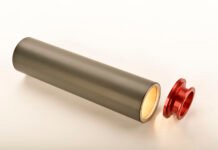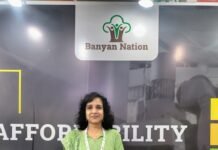Rajhans seems to have quickly mastered the flexible packaging business – producing everything in-house from extrusion blown films to digital flexo plate imaging right up to printing, lamination, slitting and pouch-making.
 The Bengaluru-headquartered Rajhans Enterprises group was a diversified offset business – a supplier of newspaper contract printing, commercial and book printing and carton packaging-until it launched its flexible packaging plant in the Bidadi industrial area just three years ago. (It did enter the narrow web flexo label segment with a Gallus press but labels seem to have taken a back seat to the more scalable flexible business.) The modern purpose built plant at Bidadi started with an Indian manufactured 9-color gravure press from Expert. Since then, the company seems to have quickly mastered the flexible packaging business – producing everything in-house from extrusion blown films to digital flexo plate imaging right up to printing, lamination, slitting and pouch-making.
The Bengaluru-headquartered Rajhans Enterprises group was a diversified offset business – a supplier of newspaper contract printing, commercial and book printing and carton packaging-until it launched its flexible packaging plant in the Bidadi industrial area just three years ago. (It did enter the narrow web flexo label segment with a Gallus press but labels seem to have taken a back seat to the more scalable flexible business.) The modern purpose built plant at Bidadi started with an Indian manufactured 9-color gravure press from Expert. Since then, the company seems to have quickly mastered the flexible packaging business – producing everything in-house from extrusion blown films to digital flexo plate imaging right up to printing, lamination, slitting and pouch-making.
 Apart from the Bidadi plant which is a neighbor of CocaCola and Toyota, Rajhans’ offset operations in Bengaluru produce commercial print such as calendars, product brochures, catalogs and collateral as well as technical journals and books apart from complete monocarton production including finishing and converting. These operations take up
Apart from the Bidadi plant which is a neighbor of CocaCola and Toyota, Rajhans’ offset operations in Bengaluru produce commercial print such as calendars, product brochures, catalogs and collateral as well as technical journals and books apart from complete monocarton production including finishing and converting. These operations take up
several lakh square feet in eight units in the Rajaji Nagar Industrial area. While the prepress units have the latest Kodak software driving Kodak thermal CtP devices in addition to the Kodak Flexcel NX for digital flexo plates; the pressroom contains eight multicolor sheetfed offset presses from Heidelberg, Mitsubishi, and Roland apart from the two pairs of Komori heatset presses with 578 and 546 mm cutoffs. The sheetfed offset presses include a Heidelberg XL75 6-color plus coater full UV press that is used carton printing. The converting section contains comprehensive coating, lamination, die-cutting and folder-gluers for monocarton production.
Two Macchi blown film lines

Rajhans’ investments at Bidadi for flexible packaging production have been continuous and quick for establishinga comprehensive high technology workflow that makes it one of the most capable flexible packaging suppliers in the country. In the beginning stages it opted for a Macchi 5-layer blown film extruder and a Bobst F&K 20SIX wide-web CI flexo
9 color press, Nordmeccanica laminators and SP Ultraflex slitter-rewinders. This was followed by an 8-color Rotomec gravure press and a second 5-layer blown film line from Macchi. The latest equipment already on order is a second CI wide-web flexo press from F&K configured for 7-color extended gamut printing that should be installed in the SeptemberOctober time frame. There are other purchases that are being contemplated but it’s a bit early to talk about these – suffice to say, this flexible packaging plant intends to bring the best quality to Indian brands owners with the best technology that it can find and integrate.

Although the modern second generation Akash runs the flexible packaging business Balachandra is focussed on R&D for achieving quality. When brand owners and flexible packaging converters attended the Open house event at Bobst Bielefeld in February 2018, Rajhans was one of the two Indian companies and the only flexible packaging printer that took part in the 7-color extended gamut printing (ECG) demonstrations and discussions. The company ordered the Bobst F&K20SEVEN 8-color press that was featured at Bielefeld.
Controlled inking is of great importance in ECG printing and the F&K20SEVEN press features what is called a smartFLO inking system and chamber

doctor blade for optimizing the temperature and flow of ink which delivers predictable, stable and controlled printing results with both solvent-based and water-based inks. This should enable users to take full advantage of the opportunities of ECG to reduce changeovers for many of the special ink colors and manufacturing costs, Operational consistency should increase with a reduction of variables and errors due to manual setting of ink levels.
Rajhans is poised take advantage of ECG capabilities on the new press. The company installed a mid-size Kodak Flexcel NX digital imaging system and a GPS plate mounter in
preparation for its first F&K CI press in 2015. It routinely uses 175 lpi screen ruling for its digital flexo plates that are also supplied by Kodak. The prepress capability helps the company to understand the benefits of printing flexible packaging with a fixed 7-color set of inks that can yield extended gamut results. Nevertheless on the new CI flexo press too, there is an 8th unit that can still produce the special and brand colors that may still be required.
Brand owners need to be educated on ECG benefits

Bengaluru
Apart from the prepress side for extended gamut printing with 7 colors for which Rajhans is ready, there is still the need to educate and convince the brand owners and packaging designers and buyers of the efficacy and advantages of this new method that is gaining popularity worldwide and now in India as well.
The 35-year-old family owned company in which the next generation have joined as partners and taken responsibility is still nevertheless managed and run by brothers A Ravindranath and A Balachandra. Of the two next generation partners, AR Aswath looks after the offset print segments while AB Akash looks after the flexible packaging operation. Notably, Balakri still looks after the purchasing of all materials, a responsibility to which he quite openly attaches great importance although he has a benign policy of loyalty to reliable and competitive suppliers.

Bengaluru
Balachandra keeps a tight control on quality by investing in high-end machines and the best raw materials. He is quick to point out that the purchasing function for equipments and consumables is a key to the printing and packaging business and that because of his personal involvement, Rajhans is able to offer the best quality at a best price which he feels is competitive. He is happy to work with many of the mid to large size consumer product companies and avoids working only for the large brands. “They don’t differentiate between what we offer in terms of technology, quality, timeliness and reliability and other printers who do not have plants such as ours,” he explains, adding that, “We are ready to print all kinds of work and we do good work for so many of the regional and local FMCG companies. At the same time we can scale up to the largest quantities but we don’t want to be dictated to by the large brand owners,” he says.











